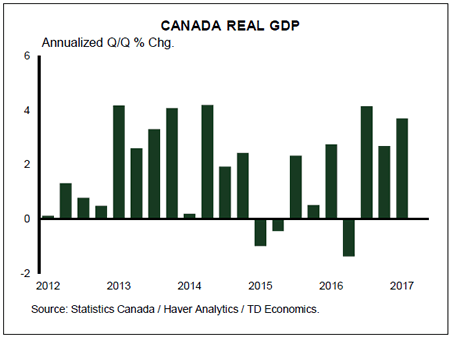U.S. Highlights
- A very quiet week for economic data had markets anticipating Chair Yellen’s remarks at Jackson Hole. Her speech largely went over old ground on financial stability and the role of regulation.
- Next week, President Trump is expected to join the chorus of Republicans promoting tax reform. We still don’t know the details, but September is likely to see the debate heat up as Congress gets down to brass tacks writing legislation.
- Add to that the potential for an 11th hour solution on the debt ceiling and funding government beyond September, and investors could be kept on the edge of their seats over the next couple of months.
Canadian Highlights
- NAFTA negotiations this week progressed behind closed doors, as the U.S. President repeated a campaign threat to repeal the agreement, suggesting a tough bargaining stance.
- Retail trade data this week confirmed that household consumption would contribute strongly to economic growth in the second quarter, owing largely to a continuation of solid performance for consumer durables.
- Looking ahead, rising interest rates and weaker home prices are likely to provide material headwinds to household consumption growth.

U.S. – Washington Likely to Keep Markets on Edge
September is likely to keep markets on the edge of their seats awaiting details of tax reform plans, and the potential for fireworks surrounding the debt ceiling and funding government beyond September (see recent report). The GOP surely needs some kind of legislative achievement to show voters in the mid-term elections, raising the stakes to get some kind of tax reform done in short order. Last week’s market turmoil demonstrated just how sensitive markets are to signs that Trump might not be able to implement his lower-tax pro-business agenda.
President Trump is scheduled to start making speeches in support of tax reform next week. Joining in with the chorus of GOP Members of Congress stumping their tax reform plans throughout August. But, we still do not know the details of what that agenda will look like. The high level statement of principles released before the August recess by the "Group of Six", was meant to give direction to the two tax-reform writing committees (House Ways & Means and Senate Budget) that will hash out the gory details of the package in September.
We know the controversial border adjustment tax is off the table. Reading between the lines of the statement, they are (not surprisingly) seeking to lower the corporate tax rate, lower taxes for "pass-through" businesses, and likely move towards full expensing of capital expenditures. Recent leaks from the process suggest a corporate rate between 22-25% is being considered. The Tax Foundation has estimated that reducing the CIT rate to 25% and allowing full expensing costs $1.2 trillion (tn) over ten years. On the flip side, eliminating the deductibility of interest payment would generate $1.2 tn, at current tax rates. Allowing companies to repatriate cash from overseas at a one-time low tax rate, is almost certain to be included and would generate between $140-150 billion.
On the personal side, there is talk of capping the mortgage interest deduction. That could generate over $300 bn if it is the level of eligible debt is capped at $500K, and would largely be paid by taxpayers in the top 20% of incomes. Repealing the state and local tax deduction, would also generate significant revenue (potentially $1.7 tn). These "pay-fors" could fund lower personal tax rates or double the standard deduction, which would improve simplicity, and benefit middle-income taxpayers the most.
On a back of the envelope basis, these potential tax changes don’t yet appear to be deficit neutral. There are three ways the GOP can overcome this: cut government spending, reduce the size of tax breaks or allow tax cuts to "sunset" like the Bush tax cuts. A sunset clause would create a new fiscal cliff ten years down the line and reduce the economic impact of he changes. Budget proposals have between $4 tn (Trump) and nearly $7 tn (House) in spending cuts relative to CBO’s baseline. While these are unlikely to pass in their current form, they would generate plenty of fiscal room for tax cuts. Or, the GOP could opt for a much more modest package, and call it a "down payment" on further reforms they could implement if they manage to secure a filibuster-proof majority in the Senate in 2018. With markets clearly sensitive to developments in Washington, this fall should prove to be exciting, for better or worse.
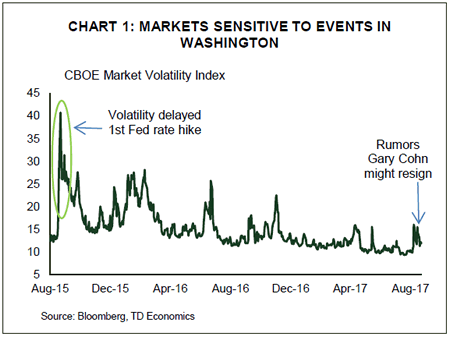
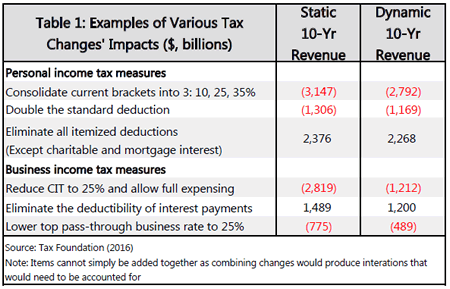
Canada – Strong Household Spending to Wane
The week prior to quarterly Canadian GDP releases are typically quiet, and this week was no exception. Earlier in the week, the U.S. President repeated a campaign threat to scrap NAFTA, revealing a tough bargaining stance less than a week after negotiations began. While initially this threat caused the Canadian dollar to selloff slightly, this quickly reversed later in the week following the release of June’s retail trade data.
Retail sales rose 0.5% month-on-month in June, marking the sixth consecutive increase in volume terms. This was the last piece of evidence to confirm that household consumption has contributed strongly to second quarter economic growth. Indeed, the 8.8% (quarterly annualized) rate of expansion in retail sales volumes follows on the heels of two stellar performances in the previous two quarters. Overall, we anticipate that next week’s Statistics Canada report will reveal the Canadian economy expanded at a 3.7% quarterly annualized rate, with household consumption contributing more than two percentage points for the second consecutive quarter.
With second quarter economic growth now all but confirmed, the obvious question is what does this mean for future economic activity. More directly, how long can Canadian households sustain this level of spending? The average Canadian household is highly indebted (Chart 1), largely owing to mortgage growth when the housing market was in an upcycle in an ultra-low interest rate environment. In addition, recent strength in consumer spending has been fueled by the purchase of consumer durables; big-ticket items such as cars, trucks, furniture and appliances.
Global and domestic interest rates are clearly on the rise. The economic recovery in a number of advanced economies is nearly complete, and monetary policymakers are looking to remove the extraordinary measures undertaken to help combat the Great Recession. The Fed is on track to begin balance sheet normalization this fall, and will likely raise rates by a cumulative 75bps by the end of 2018. Similarly, robust economic activity in Canada to date should lead the Bank of Canada to remove remaining emergency stimulus this year, then tighten monetary conditions twice more in 2018.
Given the reliance of Canadian consumption on household credit and house price related wealth effects (Chart 2), it’s difficult to make a case that the recently observed pace of consumption growth can continue in a rising interest rate environment, especially absent a substantial increase in household income. Moreover, new housing regulations introduced by the provincial government, together with increased mortgage lending oversight by OSFI, seems to have at least temporarily knocked the wind out of the GTA housing market, but the ripple effects on the Canadian economy are still forthcoming.
Altogether, higher interest rates and weaker house prices are likely to provide a headwind to household consumption growth in upcoming quarters. This was noted in our June quarterly economic forecast in which household consumption growth was forecast to slow to 1.7% next year from its above 3.0% pace this year. Canadian automotive, furniture, and appliance dealers take note: enjoy the good times while they last.
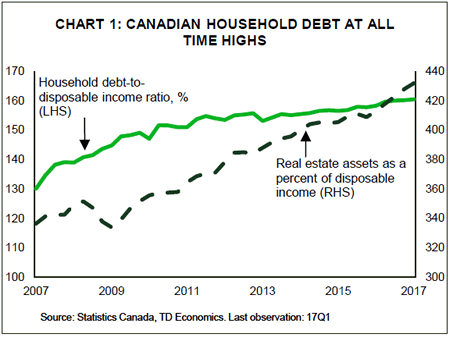
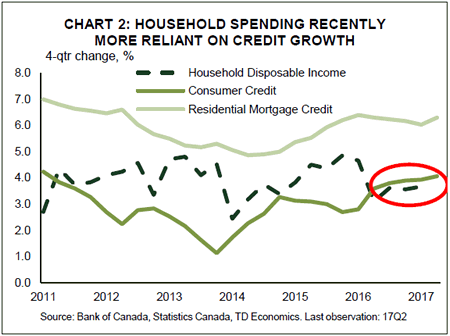
U.S.: Upcoming Key Economic Releases
U.S. Personal Income & Spending – July
Release Date: August 31, 2017
Previous Result: Income 0.0% m/m, Spending 0.1% m/m
TD Forecast: Income 0.4% m/m, Spending 0.4% m/m
Consensus: Income 0.3% m/m, Spending 0.4% m/m
Headline PCE inflation is expected to reaccelerate to 1.6% in July, reflecting a 0.1% rise in prices on the month. A drag from energy prices will be offset by gains in food and core categories. We expect a 0.1% rise in the core PCE index, leaving the core inflation rate stable at 1.5% y/y. By comparison, the core CPI rose 0.1% in July, reflecting a continued drag from cellphone services and vehicle prices. We expect a similar gain in the PCE index, with downside risk given the potential for healthcare services prices to underperform the recorded rise in the CPI.
Nominal PCE (personal spending) is expected to post a solid 0.4% rise in July, providing solid footing for Q3 consumer spending which we track just under a 3% annual pace. The July gain should reflect broadly based increases across goods and services. We also expect a solid 0.4% increase in July personal income, following a flat read in the previous month that was caused by a sharp drop in dividends.
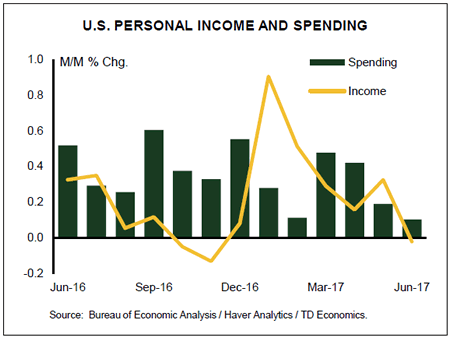
U.S. ISM Manufacturing Index – August
Release Date: September 1, 2017
Previous Result: 56.3
TD Forecast: 56.7
Consensus: 56.5
TD looks for ISM Manufacturing to rebound to 56.7 vs 56.3. Regional surveys on balance point to a pickup, as does steady growth in core manufacturing production. Forward-looking indicators (new orders) remained a robust levels through July, consistent with healthy activity in Q3. One source of downside risk in August are market risk sentiment and political risk factors, including the start of Nafta renegotiations and political controversy stemming from the administration.
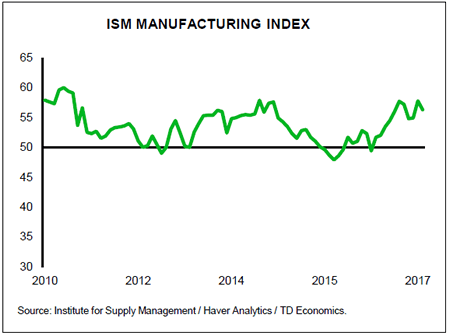
U.S. Employment – August
Release Date: September 1, 2017
Previous Result: 209k, unemployment rate 4.3%
TD Forecast: 175k, unemployment rate 4.3%
Consensus: 180k, unemployment rate 4.3%
We expect August nonfarm payroll employment to moderate to a 175k pace after registering a robust 209k gain in July, which left the 6-month average little changed at 179k. While data is limited so far for the month of August, the past trend in survey and hard data indicators point to job growth well above its breakeven pace of roughly 100k. In August, we call for a small deceleration led by private services, which picked up by a strong 183k in July, and a potential contraction in mining jobs in line with the decline in rig counts. Manufacturing jobs are expected to maintain a steady pace of growth near 10k.
We expect the unemployment rate to be unchanged at 4.3%, with risks balanced as further improvement in labor participation cannot be excluded in the near-term. On wages, we expect a 0.2% m/m increase, taking in account unfavorable calendar effects that bias the monthly gain downward. The rise should lead average hourly earnings slightly higher on a year-on-year basis to 2.6% vs 2.5%. Overall, the combination of solid job growth and a pickup in wage gains argues for a hawkish report, though the market response will be tempered by concerns over low inflation and near-term political risks.
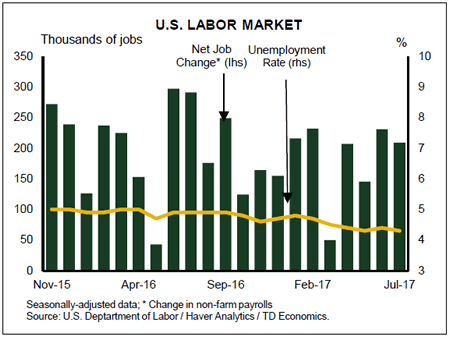
Canada: Upcoming Key Economic Releases
Canadian Real GDP – June
Release Date: August 31, 2017
Previous Result: 3.7% q/q, 0.6% m/m
TD Forecast: 3.7% q/q, 0.1% m/m
Consensus: 3.6% q/q, 0.1% m/m
The Canadian economy is expected to have expanded by 3.7% (q/q, annualized) in the second quarter of 2017 – matching its performance from the first quarter of the year. Just like in the first quarter, consumer spending (+3.9%) will provide a healthy support for economic growth with particular strength in durable goods (+8.4%) spending as auto sales rose above 2.1 million units (annualized) for the first time ever. Non-residential fixed investment (+6.3%) should also contribute strongly to growth with both equipment and structures seeing solid gains – the latter helped by rebounding drilling activity in energy producing provinces. Net trade should also provide a helping hand. After largely flat performance over the previous two quarters, exports are expected to rebound sharply (+10.6%) and outpace the still healthy import growth (+7.6%). The net trade pickup is a welcome development that came just as a key driver of growth in previous quarters, residential investment, fizzled out. After growing by 15.7% in the first quarter, residential investment (-2.5%) will decline alongside a sharp pullback in existing home sales in the Greater Toronto Area. Finally, a slower inventory build-up than in the first quarter should also provide a modest drag to growth in the second quarter.
Looking to the month of June, we expect industry-level GDP to expand 0.1%. Growth will be dragged down by real estate industry, on account of declining activity in the existing home market and goods-producing sector given the weakness in manufacturing activity during the month. At the same time, retail and leisure should provide an important offset with construction activity also likely posting a healthy gain. The relatively soft print for June GDP should provide a relatively weak handoff to Q3, where we expect growth to moderate to below 2% – a pace that’s largely consistent with potential economic growth.
